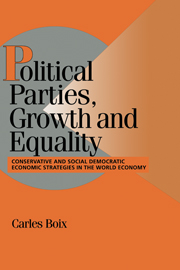 Political Parties, Growth and Equality
Political Parties, Growth and Equality Published online by Cambridge University Press: 05 June 2012
As argued in the two first chapters, governments eventually have to choose between two alternative economic strategies to spur economic growth and sustain the competitiveness of domestic firms in the medium run. In one case, governments employ the public sector to raise the level of domestic savings and total investment and boost the productivity of capital and labor. In the other case, they rely on market mechanisms and private agents to maximize the rate of investment and thus foster economic growth. Although equally geared toward improving economic performance, each economic strategy has distinct redistributive effects. Public investment strategies, developed to equalize conditions without forsaking growth, require higher taxes on well-off sectors. Private investment strategies imply a reduction in taxes and in current levels of social protection – particularly when exogenous shocks exacerbate the employment–equality tradeoff latent in all advanced democracies. The two strategies accordingly receive the support of different parties and electoral constituencies. Broadly speaking, social democrats and working-class voters rally around active supply-side policies. Conservatives and the middle classes defend privatization policies and tax reductions. We must now turn to the task of empirically testing the model put forward in Chapters 1 and 2.
This chapter is organized as follows. The first section shows how supply-side policy choices have diverged substantially across countries and over time. The data presented dispel a rather widespread belief that there is a unique governmental strategy toward the supply side of the economy.
To save this book to your Kindle, first ensure [email protected] is added to your Approved Personal Document E-mail List under your Personal Document Settings on the Manage Your Content and Devices page of your Amazon account. Then enter the ‘name’ part of your Kindle email address below. Find out more about saving to your Kindle.
Note you can select to save to either the @free.kindle.com or @kindle.com variations. ‘@free.kindle.com’ emails are free but can only be saved to your device when it is connected to wi-fi. ‘@kindle.com’ emails can be delivered even when you are not connected to wi-fi, but note that service fees apply.
Find out more about the Kindle Personal Document Service.
To save content items to your account, please confirm that you agree to abide by our usage policies. If this is the first time you use this feature, you will be asked to authorise Cambridge Core to connect with your account. Find out more about saving content to Dropbox.
To save content items to your account, please confirm that you agree to abide by our usage policies. If this is the first time you use this feature, you will be asked to authorise Cambridge Core to connect with your account. Find out more about saving content to Google Drive.